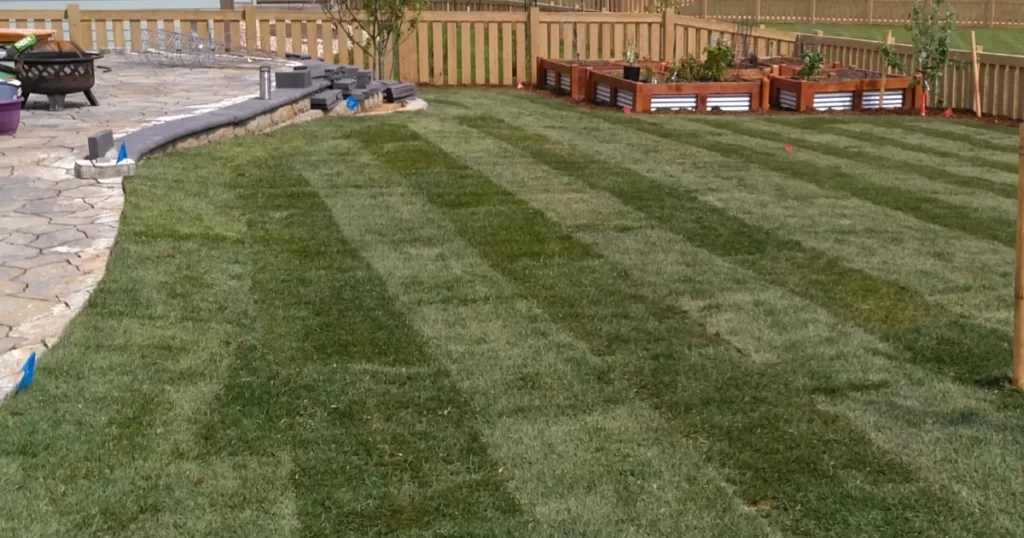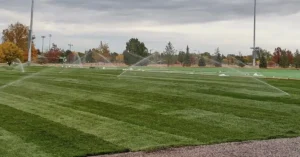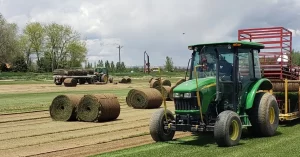Looking for sod installation, sod preparation and achieving a great lawn in Colorado or Wyoming including Fort Collins, Denver, Greeley, and much more? We have put this sod installation guide as well as links to useful articles for those considering sod installation.
The key to a successful installation lies in preparation, starting with evaluating the lawn’s requirements and ensuring the soil is conducive to healthy growth. Applying starter fertilizer before laying the sod can provide a nutrient-rich foundation, encouraging roots to penetrate deep into the soil. A flat rate is often sought after for projects, making budgeting for the task more manageable and straightforward.
Preparing for Sod Installation
Before starting on sod installation, it’s crucial to assess the lawn’s condition and prepare the ground accordingly. This preparation involves removing weeds, testing the soil, and ensuring the site is level. Understanding the importance of these preparatory steps can significantly impact the sod’s ability to take root and flourish. Korby Sod does provide sod installation services as well as sod prep and sod removal for Denver, Fort Collins, Wellington, Greeley and the Colorado Front.
Evaluating Your Lawn’s Needs
Evaluating your lawn involves understanding its unique conditions and challenges. Using a sod cutter for removing existing grass and weeds can be an effective first step in preparing the area for new sod. This initial evaluation is critical in planning for a successful sod installation, tailored to your lawn’s specific needs.
Soil Testing Importance
Soil testing plays a pivotal role in the sod installation process. By taking a soil sample and analyzing its composition, you can determine the soil pH and nutrient levels. This information is crucial for adjusting the soil conditions to ensure they are optimal for sod installation, promoting healthy growth from the start.
Soil Preparation Techniques
Soil preparation is a multi-step process that involves removing existing grass, improving soil structure, and ensuring proper drainage. Incorporating organic matter and leveling the ground are also key steps in creating a conducive environment for sod roots to grow and thrive.
The Role of Rototilling in Sod Installation
Rototilling is an effective technique for breaking up compacted soil, which is essential for sod installation. This process allows for better air and water infiltration and facilitates easier root penetration. Preparing the soil thoroughly through rototilling can significantly enhance the sod’s ability to establish itself and grow vigorously.
Optimal Conditions for Sod Installation
For sod installation to be successful, certain conditions need to be met. These include adequately prepared soil, the right weather conditions, and timely watering. Ensuring these conditions can lead to a seamless sod installation process and a healthy, thriving lawn.
Best Time of the Year to Lay Sod
Cool season turfgrasses from Korby Sod can be installed year round! They are more accustomed to cool weather and can tolerate being planted in the middle of winter. Care is simple and you MAY need to water. For more information about sod installation during winter visit can you install sod during the winter?
The Step-by-Step Sod Installation Process
The sod installation process involves several key steps, from preparing the soil to laying the sod and ensuring it establishes well. Following these steps carefully can lead to a beautifully installed lawn that enhances your outdoor space.
How to Prepare Your Soil for Sod
Preparing your soil for sod involves removing existing grass, testing the soil pH, and applying starter fertilizer to provide essential nutrients. Ensuring the soil is loose and aerated allows roots to penetrate deeply and establish more quickly, promoting a healthier lawn.
Leveling Your Lawn for a Uniform Appearance
Leveling your lawn before installing sod is crucial for a uniform appearance. This step involves smoothing out bumps and filling in low spots to prevent water pooling. A level surface ensures each sod piece connects well with the soil, creating a seamless lawn.
Mastering the First Row for a Solid Foundation
Starting with a straight edge and laying the first row of sod carefully sets the foundation for the entire lawn. Ensuring the first row is properly aligned and snug against the edge provides a guideline for subsequent rows, leading to a professional-looking finish.
Strategies for Laying the Next Rows of Sod
After the first row, it’s important to stagger the joints in subsequent rows, much like laying bricks. This strategy prevents lines from aligning directly across the lawn, which can lead to uneven growth and visible seams. Properly laying the next rows ensures a strong, cohesive lawn surface.
Initial Lawn Care: Watering and Maintenance
Initial lawn care involves regular maintenance to ensure the sod establishes well. The lawn receives adequate water to encourage deep root growth, and lawn mowing begins once the sod has rooted firmly. This early stage care is vital for developing a resilient and healthy outdoor space.
When to Mow New Sod for the First Time
Mowing new sod for the first time should occur once it has rooted firmly, typically two to three weeks after installation. Ensuring the grass has reached a height of at least 3 inches before the first mow encourages healthy growth and helps establish a thick, lush lawn.
The Importance of Fertilizing New Sod
Fertilizing new sod is crucial for its healthy growth. It provides essential nutrients that help the sod establish strong roots in the new environment. A well-timed fertilizer application encourages lush, green growth, making the lawn more resilient against pests and diseases. Homeowners should select a fertilizer specifically designed for new sod to ensure it receives the right balance of nutrients.
Maintaining Your New Sod Lawn
After installing new sod, maintaining it properly is key to ensuring its longevity and beauty. Regular watering, timely mowing, and appropriate fertilization are fundamental practices. Addressing any signs of distress early can prevent common sod problems, keeping the lawn looking vibrant and healthy. Additional information about sod watering and aftercare
Watering Guidelines for New Sod
Proper watering is essential to settle the soil and help the new sod establish its roots. Initially, the sod requires frequent, light watering to keep the soil moist but not waterlogged. Gradually reducing the watering frequency encourages the roots to grow deeper, creating a more drought-resistant lawn.
Mowing Tips for a Healthy Lawn
When it comes to newly installed sod, the first mowing is critical. It’s important to wait until the sod is well-rooted, usually two to three weeks after installation. Mowing at the right height can promote healthy growth without putting too much stress on the young grass. Sharp mower blades ensure a clean cut, which helps prevent disease.
Addressing Common Sod Maintenance Challenges
Maintaining new sod involves vigilance. Homeowners should watch for signs of pests, under or over-watering, and nutrient deficiencies. Early detection and correction of these issues can prevent them from escalating into bigger problems, ensuring the lawn remains healthy and attractive.
Identifying and Solving Common Sod Problems
Common sod problems include yellowing, bare patches, and weed invasion. Identifying the underlying cause is the first step to solving these issues. Adjusting the watering schedule, applying the right fertilizer, or implementing weed control measures can often remedy these problems, restoring the lawn’s lush, green appearance.
Expert Tips and Tricks for Sod Installation
Installing sod can transform a yard quickly, but doing it right requires some know-how. Preparing the soil properly, choosing the right time of year, and laying the sod carefully around curves and obstacles can make a big difference in the outcome. Following expert advice can help avoid common pitfalls and ensure the sod establishes well.
Laying Sod Around Curves and Obstacles
Laying sod around curves and obstacles requires careful planning. Cutting the sod pieces to fit snugly ensures complete coverage and prevents gaps where weeds could grow. Keeping the grass roots in contact with the soil is crucial for successful sod installation in these challenging areas.
How Long to Stay Off of New Sod to Ensure Rooting
It is important to stay off new sod until it has firmly rooted, typically for about two to three weeks. Limiting foot traffic during this time helps the sod establish without disruption, ensuring it grows evenly and becomes well-integrated with the underlying soil for a durable, healthy lawn.
Frequently Asked Questions About Sod Installation
Sod installation raises many questions, from the cost considerations to the best practices for lawn maintenance. Understanding the process, including when to install new sod and how to care for it, can help homeowners achieve a lush, green lawn they can enjoy for years to come.
Cost Considerations for Sod Lawn Installation
The cost of sod lawn installation varies, depending on the size of the area, the type of sod, and labor costs. Professional sod installation might seem expensive, but it includes preparation, labor, and the sod itself. Planning and scheduling delivery efficiently can help manage expenses, ensuring the lawn installation process is as cost-effective as possible.
Sod Installation Myths Debunked
Many myths surround sod installation, such as the idea that sod can only be installed in certain seasons or that it requires less maintenance than seeded lawns. In reality, sod can be installed almost year-round in many climates, and while it establishes faster, it still requires proper care, including regular watering, mowing, and fertilization, to thrive.
Wrapping Up Sod Installation Journey: A Greener Tomorrow
After the sod delivery arrives and the last piece of turf grass settles into the soil, a new chapter begins for homeowners aiming for a lush, green lawn. Root growth and development are crucial, and with proper care, the roots will dig deep into the earth, creating a strong foundation for your lawn. Adjusting the soil’s pH and ensuring the installation process is carefully followed prevents scenarios where the grass is dead before it even has a chance to thrive. For those with sloped areas, additional attention to securing the sod can lead to successful establishment, avoiding the wash-away risk during heavy rains. As you embark on this journey, remember, with the right lawn starter and dedication to maintenance, a greener tomorrow is not just a dream but a reality within reach.
Sod Installation in Denver, Fort Collins & More
If you were looking to replace your sod or installation of new sod, you come to the right place! Korby Sod provides full Sod service, including sod, sod installation, prep and sod removal, Sod delivery and much more. We have several varieties to choose from including Vortex Hybrid Sod, Athletic Sports Turf and Black Beauty Xeriscape and are happy to help. Give us a call at (970) 568-7633 or (720) 262-3818 for more information.




